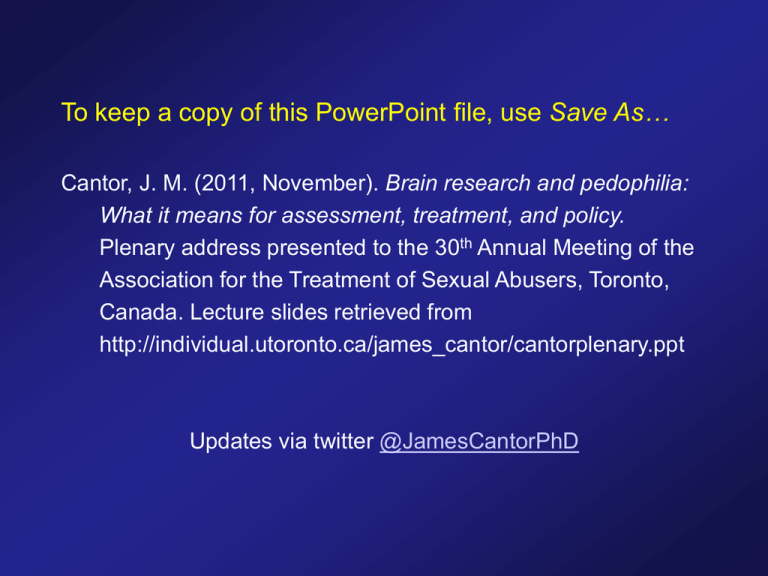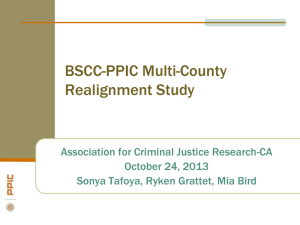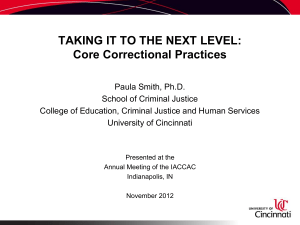
To keep a copy of this PowerPoint file, use Save As…
Cantor, J. M. (2011, November). Brain research and pedophilia:
What it means for assessment, treatment, and policy.
Plenary address presented to the 30th Annual Meeting of the
Association for the Treatment of Sexual Abusers, Toronto,
Canada. Lecture slides retrieved from
http://individual.utoronto.ca/james_cantor/cantorplenary.ppt
Updates via twitter @JamesCantorPhD
Brain Research and Pedophilia:
What it means for assessment,
treatment, and policy
James M. Cantor, PhD
Head of Research, CAMH Sexual Behaviours Clinic
Associate Professor of Psychiatry, University of Toronto
Editor-in-Chief, Sexual Abuse: A Journal of Research and Treatment
The Big Questions
Is it in the brain?
Can we treat it?
Is it in the genes?
Were they born with it?
Does it run in families?
Can it change?
Are they responsible for it?
Can we prevent it?
1886
Founding of modern sexology
1900–2000 Large scale studies of forensic samples
1980–1999 Neuropsych testing, early imaging (CT) studies
1999
First neuroimaging study of sexual arousal
Sexual Large-scale
Offending
andof homogeneous
the Brain:samples
History
2000–
studies
2007–2008 High-resolution studies of pedophilia published
2007
First fMRI studies of pedophilia published
Richard von Krafft-Ebing (1840–1902)
Richard von Krafft-Ebing (1840–1902)
Psychopathia Sexualis (1886)
Richard von Krafft-Ebing (1840–1902)
Psychopathia Sexualis (1886)
Sexual anomalies are a
“diseased condition of the
central nervous system” (p. 61).
Sexual Offending and the Brain: History
1886
1900–2000
1980–1999
1999
2007–2008
2007
Founding of modern sexology
Large scale studies of forensic samples
Neuropsych testing, early imaging (CT) studies
First neuroimaging study of sexual arousal
High-resolution studies of pedophilia published
First fMRI studies of pedophilia published
Meta-Analysis of all reports, 1931–2004
• 75 reports with IQ data
• 236 non-overlapping samples
• 25,146 cases (7,045 sexual offenders and 18,101 controls)
IQ Findings
—Cantor, Blanchard, Robichaud, & Christensen (2005). Psychological Bulletin, 131, 555–568.
Adjusted Mean IQ Score (s.e.)
IQ of Adult Samples by Victims’ Age Group
110
105
100
95
90
85
Sexual
Offenders
Against
Children
Sexual
Offenders
Against Adults
Nonsexual
Offenders
Nonoffenders
—Cantor, Blanchard, Robichaud, & Christensen (2005). Psychological Bulletin, 131, 555–568.
Sexual
Offenders,
Victims' Ages
Mixed or
Unknown
Adjusted Mean IQ Score (s.e.)
IQ of Adult Samples by Victims’ Age Group
F (4, 158) = 7.74
p < .0001
110
105
100
95
90
k=56
k=8
k=53
k=12
k=36
Sexual
Offenders
Against
Children
Sexual
Offenders
Against Adults
Nonsexual
Offenders
Nonoffenders
Sexual
Offenders,
Victims' Ages
Mixed or
Unknown
85
—Cantor, Blanchard, Robichaud, & Christensen (2005). Psychological Bulletin, 131, 555–568.
IQ by Definition of “Child” Victim
Samples' Mean IQ
115
r (29) = .50
p = .005
110
105
100
95
90
85
12
13
14
15
16
17
18
Cutoff Defining "child"
—Cantor, Blanchard, Robichaud, & Christensen (2005). Psychological Bulletin, 131, 555–568.
19
Sexual Offending and the Brain: History
1886
1900–2000
1980–1999
1999
2007–2008
2007
Founding of modern sexology
Large scale studies of forensic samples
Neuropsych testing, early imaging (CT) studies
First neuroimaging study of sexual arousal
High-resolution studies of pedophilia published
First fMRI studies of pedophilia published
Frontal Lobe vs. Temporal Lobe Theories
Frontal Lobe vs. Temporal Lobe Theories
Frontal Lobe vs. Temporal Lobe Theories
Inhibition/
self-control
The 4 F’s
Neuropsychological Batteries
Halstead-Reitan Battery
Yeudall (1977)
Yeudall et al. (1979)
Langevin et al. (1985)
Langevin et al. (1988)
Langevin et al. (1989)
Rapists
Heterogeneous
Sadists
Sexual killers, aggressives
Exhibitionists
Luria-Nebraska Battery
Graber et al. (1982)
Scott et al. (1984)
Hucker et al. (1986)
Hucker et al. (1988)
Langevin et al. (1988)
Galski et al. (1990)
Heterogeneous
Offenders vs. children, adults
Pedophiles
Sadists, sexual aggressives
Sexual killers, aggressives
Heterogeneous
Neuropsychological Batteries
Halstead-Reitan Battery
Yeudall (1977)
Rapists
Yeudall et al. (1979)
Heterogeneous
Langevin et al. (1985)
Sadists
Langevin et al. (1988)
Sexual killers, aggressives
Langevin et al. (1989)
Exhibitionists
Indications of general
impairment.
No reliable localization.
Luria-Nebraska Battery
Graber et al. (1982)
Scott et al. (1984)
Hucker et al. (1986)
Hucker et al. (1988)
Langevin et al. (1988)
Galski et al. (1990)
Heterogeneous
Offenders vs. children, adults
Pedophiles
Sadists, sexual aggressives
Sexual killers, aggressives
Heterogeneous
Trail-Making
Bowden (1987)
Cohen et al. (2002)
Dolan et al. (2002)
Knox-Jones (1994)
Langevin et al. (1989)
Stone & Thompson (2001)
Tarter et al. (1983)
Yeudall et al. (1987)
Controlled Oral Word Assoc.
Cohen et al. (2002)
Dolan et al. (2002)
Gillespie & Mckenzie (2000)
Knox-Jones (1994)
Rubenstein (1992)
Stone & Thompson (2001)
Yeudall et al. (1987)
Wisconsin Card Sort
Cohen et al. (2002)
Dolan et al. (2002)
Kruger & Schiffer (2011)
Miller (1997)
Rubenstein (1992)
Stone & Thompson (2001)
Westergren (2002)
Yeudall et al. (1987)
Wechsler Memory Scale
Dolan et al. (2002)
Knox-Jones (1994)
Langevin et al. (1989)
Rubenstein (1992)
Tarter et al. (1983)
Williams Verbal Learning Test
Abracen et al. (1991)
Baker (1985)
O’Carroll (1989)
Yeudall et al. (1986)
Finger-Tapping
Knox-Jones (1994)
Langevin et al. (1989)
Tarter et al. (1983)
Yeudall et al. (1986)
Stroop
Cohen et al. (2002)
Dolan et al. (2002)
Stone & Thompson (2001)
Gillespie & Mckenzie (2000)
Bender Gestalt Test
Lewis et al. (1979)
Yeudall et al. (1986)
Individual Neuropsychological Tests
Individual Neuropsychological Tests
Trail-Making
Bowden (1987)
Cohen et al. (2002)
Dolan et al. (2002)
Knox-Jones (1994)
Langevin et al. (1989)
Stone & Thompson (2001)
Tarter et al. (1983)
Yeudall et al. (1987)
Controlled Oral Word Assoc.
Cohen et al. (2002)
Dolan et al. (2002)
Gillespie & Mckenzie (2000)
Knox-Jones (1994)
Rubenstein (1992)
Stone & Thompson (2001)
Yeudall et al. (1987)
Wisconsin Card Sort
Cohen et al. (2002)
Dolan et al. (2002)
Kruger & Schiffer (2011)
Miller (1997)
Rubenstein (1992)
Stone & Thompson (2001)
Westergren (2002)
Yeudall et al. (1987)
Wechsler Memory Scale
Dolan et al. (2002)
Knox-Jones (1994)
Langevin et al. (1989)
Rubenstein (1992)
Tarter et al. (1983)
Williams Verbal Learning Test
Abracen et al. (1991)
Baker (1985)
O’Carroll (1989)
Yeudall et al. (1986)
Finger-Tapping
Knox-Jones (1994)
Langevin et al. (1989)
Tarter et al. (1983)
Yeudall et al. (1986)
Stroop
Cohen et al. (2002)
Dolan et al. (2002)
Stone & Thompson (2001)
Gillespie & Mckenzie (2000)
Bender Gestalt Test
Lewis et al. (1979)
Yeudall et al. (1986)
Individual Neuropsychological Tests
Controlled Oral Word Assoc.
Wisconsin Card Sort
Trail-Making
Cohen et al. (2002)
Cohen et al. (2002)
Bowden (1987)
Dolan et al. (2002)
Dolan et al. (2002)
Cohen et al. (2002)
Gillespie & Mckenzie (2000)
Kruger & Schiffer (2011)
Dolan et al. (2002)
Knox-Jones (1994)
Miller (1997)
Knox-Jones (1994)
Rubenstein (1992)
Rubenstein (1992)
Langevin et al. (1989)
Stone & Thompson (2001)
Stone & Thompson (2001)
Stone & Thompson (2001)
Yeudallof
et al.
(1987) impairment.Westergren (2002)
Tarter et al. (1983)
Indications
general
Yeudall et al. (1987)
Yeudall et al. (1987)
Wechsler Memory Scale
Dolan et al. (2002)
Knox-Jones (1994)
Langevin et al. (1989)
Rubenstein (1992)
Tarter et al. (1983)
Stroop
Cohen et al. (2002)
Dolan et al. (2002)
Stone & Thompson (2001)
Gillespie & Mckenzie (2000)
(Methodological confound?)
No reliable localization.
Williams Verbal Learning Test
Abracen et al. (1991)
Baker (1985)
O’Carroll (1989)
Yeudall et al. (1986)
Bender Gestalt Test
Lewis et al. (1979)
Yeudall et al. (1986)
Finger-Tapping
Knox-Jones (1994)
Langevin et al. (1989)
Tarter et al. (1983)
Yeudall et al. (1986)
CT studies
Graber et al. (1982)
Langevin et al. (1985)
Hucker et al. (1986)
Hendricks et al. (1988)
Early
Hucker et al. (1988)
Langevin et al. (1988)
Langevin et al. (1989)
Wright et al. (1990)
Offenders vs. women, children
Sadists, nonsadistic offenders
Pedophiles
Offenders
vs. children
Brain
Imaging
Sadists, nonsadistic vs. women
Incest offenders
Pedophiles
Offenders vs. women, pedophiles,
incest offenders, nonsex offenders
Early Brain Imaging
CT studies
Early Brain Imaging
CT studies
Indications of diffuse neuropathy.
No reliable localization.
Contemporary Neuropsychology and Biometrics
Mean (SE) Full-Scale IQ
110
Covariates:
age, age@ESL
F (2, 293) = 6.77
p = .001
105
100
Intelligence Quotient (IQ)
95
90
85
Pedophiles
(n=47)
Hebephiles
(n=158)
Teleiophiles
(n=93)
—Cantor, Blanchard, Christensen, Dickey, et al. (2004). Neuropsychology, 18, 3–14.
Mean (SE) HVLT-R Total Recall
Verbal Memory by Phallometric Group
25
Covariates:
age, age @ ESL
F (2, 297) = 5.08
p = .007
24
23
22
21
20
Pedophiles
(n=47)
Hebephiles
(n=161)
Teleiophiles
(n=94)
—Cantor, Blanchard, Christensen, Dickey, et al. (2004). Neuropsychology, 18, 3–14.
Mean (SE) BVMT-R Total Recall
Visuospatial Memory by Phallometric Group
25
24
Covariates:
age, age @ ESL
F (2, 255) = 6.51
p = .002
23
22
21
20
19
18
17
16
15
Pedophiles
(n=43)
Hebephiles
(n=138)
Teleiophiles
(n=79)
—Cantor, Blanchard, Christensen, Dickey, et al. (2004). Neuropsychology, 18, 3–14.
Proportions Failing or in Special Ed. by Group
80%
70%
Wald = 16.72
p = .001
Co-variates:
IQ, parental edu.
age, age @ ESL
60%
50%
40%
30%
20%
10%
0%
n=71
n=139
Teleiophilic
Nonoffenders
Teleiophilic
Sexual
Offenders
n=377
n=114
Hebephilic Men Pedophilic Men
—Cantor, Kuban, Blak, Klassen, Dickey, & Blanchard. (2006). Archives of Sexual Behavior, 35, 743–751.
Accidents Causing Unconsciousness
Age ≥ 13
p = .66
Age < 13
p = .01
35
3+ Injuries
2 Injuries
1 Injury
% with any injuries
30
25
20
15
10
5
0
i
le
Te
3
=1
(n
2
=2
(n
0
=7
(n
o
do
3
=1
(n
2
=2
(n
0
=7
(n
o
be
He
Pe
i
le
Te
do
be
He
Pe
3)
5)
)
3)
5)
)
—Blanchard, Kuban, Klassen, Dickey, Christensen, Cantor, & Blak. (2003). Archives of Sexual Behavior, 32, 573–581.
Accidents Causing Unconsciousness
Age ≥ 13
p = .66
Age < 13
p = .01
35
3+ Injuries
2 Injuries
1 Injury
% with any injuries
30
25
20
15
10
5
0
i
le
Te
3
=1
(n
2
=2
(n
0
=7
(n
o
do
3
=1
(n
2
=2
(n
0
=7
(n
o
be
He
Pe
i
le
Te
do
be
He
Pe
3)
5)
)
3)
5)
)
—Blanchard, Kuban, Klassen, Dickey, Christensen, Cantor, & Blak. (2003). Archives of Sexual Behavior, 32, 573–581.
Physical Height
Mean (s.e.) Height, in cm
180
Covariate:
age
F (4, 1220) = 4.11
p = .003
179
178
177
176
175
n=
237
n=
662
n=
178
n=
148
Pedophiles
Hebephiles
Teleiophilic
Sexual
Offenders
Teleiophilic Nonoffenders
—Cantor, Kuban, Blak, Klassen, Dickey, & Blanchard. (2007). Sexual Abuse, 19, 395–407.
Handedness in Pedophilia and Hebephilia
% non-right-handed
40
Covariates:
IQ, parental ed.,
age, age @ ESL
age: Wald = 14.25, p = .0008
sex: Wald = 0.64, p = .43
30
20
10
0
n=
325
n=
242
n=
41
n=
38
n=
40
n=
41
om
o
o
ed
P
o
om ebe
H
H
o
o
om lei
Te
H
H
o
ed
P
et e
H
eb
H
et io
H
le
Te
et
H
—Cantor, Klassen, Dickey, Christensen, Kuban, Blak, et al. (2005). Archives of Sexual Behavior, 34, 447–459.
Summary
Pedophilic men demonstrate:
• Lower IQs
• Lower scores on memory tests
• More frequent grade failure
• Less physical height
• Less right-handedness
Consistent indications of general impairment in:
large samples of
homogeneous offenders (pedophiles) with
phallometric data.
Are Brain Differences Observable Directly?
Structural MRI Studies of Pedophilia
Study
Schiltz
et al.
(2007)
Schiffer
et al.
(2007)
Cantor
et al.
(2008)
Theory
Prediction
Subjects
VBM Analysis
Structural MRI Studies of Pedophilia
Study
Theory
Prediction
Schiltz
et al.
(2007)
limbic
“temporal”
OCD/
impulsivity
frontal
Schiffer
et al.
(2007)
Cantor
et al.
(2008)
Subjects
VBM Analysis
Schiltz et al. (2007)
Study
Schiltz
et al.
(2007)
Schiffer
et al.
(2007)
Cantor
et al.
(2008)
Theory
Prediction
Subjects
limbic
“temporal”
15 pedophiles
15 community
controls
OCD/
impulsivity
frontal
VBM Analysis
Schiltz et al. (2007)
Study
Schiltz
et al.
(2007)
Schiffer
et al.
(2007)
Cantor
et al.
(2008)
Theory
Prediction
Subjects
VBM Analysis
limbic
“temporal”
15 pedophiles
15 community
controls
small volume
corrected
OCD/
impulsivity
frontal
Schiltz et al. (2007)
Study
Schiltz
et al.
(2007)
Schiffer
et al.
(2007)
Cantor
et al.
(2008)
Theory
Prediction
Subjects
VBM Analysis
limbic
“temporal”
15 pedophiles
15 community
controls
small volume
corrected
OCD/
impulsivity
frontal
Schiffer et al. (2007)
Study
Schiltz
et al.
(2007)
Schiffer
et al.
(2007)
Cantor
et al.
(2008)
Theory
limbic
OCD/
impulsivity
Prediction
Subjects
VBM Analysis
“temporal”
15 pedophiles
15 community
controls
small volume
corrected
frontal
18 pedophiles
24 community
controls
small volume
corrected
Schiffer et al. (2007)
Study
Schiltz
et al.
(2007)
Schiffer
et al.
(2007)
Cantor
et al.
(2008)
Theory
limbic
OCD/
impulsivity
Prediction
Subjects
VBM Analysis
“temporal”
15 pedophiles
15 community
controls
small volume
corrected
frontal
18 pedophiles
24 community
controls
small volume
corrected
Junk Data or Blind Monks?
Structural MRI Studies of Pedophilia
Study
Schiltz
et al.
(2007)
Schiffer
et al.
(2007)
Cantor
et al.
(2008)
Theory
limbic
OCD/
impulsivity
Prediction
Subjects
VBM Analysis
“temporal”
15 pedophiles
15 community
controls
small volume
corrected
frontal
18 pedophiles
24 community
controls
small volume
corrected
Cantor et al. (2008)
Study
Schiltz
et al.
(2007)
Schiffer
et al.
(2007)
Cantor
et al.
(2008)
Theory
limbic
OCD/
impulsivity
atheoretical
Prediction
Subjects
VBM Analysis
“temporal”
15 pedophiles
15 community
controls
small volume
corrected
frontal
18 pedophiles
24 community
controls
small volume
corrected
none
65 pedophiles
62 nonsexual
offenders
whole brain
volume
corrected
Procedures
Sexological Measures
MRI Measures
Phallometry
Automated parcellation
Self-report,
offense history
Voxel-based morphometry
(VBM)
Procedures
Sexological Measures
MRI Measures
Phallometry
Automated parcellation
Self-report,
offense history
Voxel-based morphometry
(VBM)
What’s a “voxel”?
Subjects
Patients
n = 65 sexology patients
Recruited from the Kurt Freund Laboratory (CAMH, Toronto)
Controls
n = 62 nonsexual offenders
Recruited from federal and provincial parole/probation offices
Exclusion criteria
<18 years age
>300 lbs weight
Ever suffered traumatic brain injury
Ever diagnosed with schizophrenia
Ever employed grinding metal
Any other metal object in body, counterindicating MRI
From: Cantor, Kabani, Christensen, Zipursky, Barbaree, et al. (2008). Journal of Psychiatric Research, 42, 167–183.
Subjects
Characteristic
Patients
Controls
Comparison
p
Age
36.4 (13.5)
36.9 (9.4)
t (125) = –0.23
.82
Full-Scale IQ
96.2 (15.3)
96.3 (11.5)
t (125) = –0.03
.98
Education
12.2 (3.0)
12.1 (2.8)
t (125) = 0.20
.84
1.1 (1.4)
2.1 (1.6)
t (125) = –3.8
.0003
2 (1) = 1.52
.22
CAGE alcohol
screen
% non-righthanded
23.1%
14.5%
From: Cantor, Kabani, Christensen, Zipursky, Barbaree, et al. (2008). Journal of Psychiatric Research, 42, 167–183.
VBM of Pedophilic vs. Nonsexual Offender Men
VBM of Pedophilic vs. Nonsexual Offender Men
From: Cantor, Kabani, Christensen, Zipursky, Barbaree, et al. (2008). Journal of Psychiatric Research, 42, 167–183.
VBM of Pedophilic vs. Nonsexual Offender Men
From: Cantor, Kabani, Christensen, Zipursky, Barbaree, et al. (2008). Journal of Psychiatric Research, 42, 167–183.
Superior Occipitofrontal Fasciculus
From: Cantor, Kabani, Christensen, Zipursky, Barbaree, et al. (2008). Journal of Psychiatric Research, 42, 167–183.
(right) Arcuate Fasciculus
From: Cantor, Kabani, Christensen, Zipursky, Barbaree, et al. (2008). Journal of Psychiatric Research, 42, 167–183.
But, what does this mean?
From Jellison et al. (2004). Amer J of Neurorad, 25, 356–369.
But, what does this mean?
Middle Frontal Gyrus
(Ferretti et al., 2005; Garavan et al., 2000; Gizewski et al., 2006;
Karama et al., 2002; Montosori et al., 2003; Rauch et al., 2000)
Insula and Opercula
(Garavan et al., 2000; Gizewski et al., 2006; Karama et al., 2002;
Park et al., 2001; Stoléru et al., 1999)
Sup./Inf. Parietal Lobules
(Beauregard et al., 2001; Bocher et al., 2001; Ferretti et al., 2005;
Mouras et al., 2003; Stoléru et al., 2003)
Occipital Cortex
(Beauregard et al., 2001; Bocher et al., 2001; Ferreti et al., 2005;
Garavan et al., 2000; Mouras et al., 2003; Park et al., 2001)
But, what does this mean?
1. Humans have multiple social instincts.
2. In typical men, multiple grey matter regions are networked
together to identify socially significant stimuli and evoke the
species-typical response:
●
Nurturance, parenting
● Obedience, imitation
● Sexual arousal, courtship
● Competition, combat
● Escape
…etc.
3. In pedophiles, the white matter tissue is underdeveloped and
connects the wrong stimulus to the wrong response.
?
Study
Theory
Prediction
Subjects
VBM Analysis
Schiltz
et al.
(2007)
Towards Understanding the Contradictions
Schiffer
et al.
(2007)
Why didn’t Schiltz and Schiffer find white matter?
Cantor
et al.
(2008)
Why didn’t Cantor find grey matter?
Towards Understanding the Contradictions
Study
Theory
Prediction
Subjects
VBM Analysis
Schiltz
et al.
(2007)
Why didn’t Schiltz and Schiffer find white matter?
Schiffer
et al.
(2007)
Cantor
et al.
(2008)
Why didn’t Cantor find grey matter?
Towards Understanding the Contradictions
Study
Schiltz
et al.
(2007)
Schiffer
et al.
(2007)
Cantor
et al.
(2008)
Theory
limbic
OCD/
impulsivity
atheoretical
Prediction
Subjects
VBM Analysis
“temporal”
15 pedophiles
15 community
controls
small volume
corrected
frontal
18 pedophiles
24 community
controls
small volume
corrected
unbiased
65 pedophiles
62 nonsexual
offenders
whole brain
volume
corrected
Towards Understanding the Contradictions
Study
Schiltz
et al.
(2007)
Schiffer
et al.
(2007)
Cantor
et al.
(2008)
Theory
limbic
OCD/
impulsivity
atheoretical
Prediction
Subjects
VBM Analysis
“temporal”
15 pedophiles
15 community
controls
small volume
corrected
frontal
18 pedophiles
24 community
controls
small volume
corrected
unbiased
65 pedophiles
62 nonsexual
offenders
whole brain
volume
corrected
Towards Understanding the Contradictions
Study
Theory
Prediction
Subjects
VBM Analysis
Schiltz
et al.
(2007)
Why didn’t Schiltz and Schiffer find white matter?
Schiffer
et al.
(2007)
Cantor
et al.
(2008)
Why didn’t Cantor find grey matter?
Towards Understanding the Contradictions
Study
Schiltz
et al.
(2007)
Schiffer
et al.
(2007)
Cantor
et al.
(2008)
Theory
limbic
OCD/
impulsivity
atheoretical
Prediction
Subjects
VBM Analysis
“temporal”
15 pedophiles
15 community
controls
small volume
corrected
frontal
18 pedophiles
24 community
controls
small volume
corrected
unbiased
65 pedophiles
62 nonsexual
offenders
whole brain
volume
corrected
Towards Understanding the Contradictions
Pedophilia
Fronto-occipital fasciculus
Arcuate fasciculus
Striatum
Hypothalamus
Amygdala
Orbitofrontal
cortex
Cerebellar
vermis
Anti-Sociality
Hippocampus
Prefrontal cortex
Corpus callosum
Adverse
Childhood
Events
So, can an MRI detect pedophilia?
Yes, in groups.
But…there is still disagreement over which anatomy.
No (or not yet), in individuals.
But…there is also functional brain scanning (fMRI).
Subject performs two+ tasks, including a control task.
Higher bloodflow = higher activity
functional MRI (fMRI)
Stuart Clare, FMRIB
functional MRI (fMRI)
Subject performs two+ tasks, including a control task.
Use “subtractive” statistics to compare activity between tasks.
Posner & Raichle, Images of Mind
functional MRI (fMRI)
Subject perform two+ tasks, including a control task.
Use “subtractive” statistics to compare activity between tasks.
Study
Walter et al.
(2007)
Schiffer et al.
(2008a)
Schiffer et al.
(2008b)
Poeppl et al.
(2011)
Sartorius et al.
(2008)
Ponseti et al.
(in press)
Anatomy
Subjects
Results
functional MRI (fMRI)
Subject perform two+ tasks, including a control task.
Use “subtractive” statistics to compare activity between tasks.
Study
Anatomy
Subjects
Results
Walter et al.
(2007)
whole
brain
pedophiles,
healthy controls
pedophiles respond
analogously to controls
Schiffer et al.
(2008a)
whole
brain
homosexual pedophiles,
healthy gay men
pedophiles respond
analogously to controls
Schiffer et al.
(2008b)
whole
brain
heterosexual pedophiles,
heterosexual controls
no pedophilic responses
Poeppl et al.
(2011)
whole
brain
pedophiles,
nonsexual offenders
pedophiles respond
analogously, but > controls
Sartorius et al.
(2008)
Ponseti et al.
(in press)
functional MRI (fMRI)
Subject perform two+ tasks, including a control task.
Use “subtractive” statistics to compare activity between tasks.
Study
Anatomy
Subjects
Results
Walter et al.
(2007)
whole
brain
pedophiles,
healthy controls
pedophiles respond
analogously to controls
Schiffer et al.
(2008a)
whole
brain
homosexual pedophiles,
healthy gay men
pedophiles respond
analogously to controls
Schiffer et al.
(2008b)
whole
brain
heterosexual pedophiles,
heterosexual controls
no pedophilic responses
Poeppl et al.
(2011)
whole
brain
pedophiles,
nonsexual offenders
pedophiles respond
analogously, but > controls
Sartorius et al.
(2008)
amygdala
center
homosexual pedophiles,
heterosexual controls
amygdala responded
analogously
Ponseti et al.
(in press)
functional MRI (fMRI)
Subject perform two+ tasks, including a control task.
Use “subtractive” statistics to compare activity between tasks.
Study
Anatomy
Subjects
Results
Walter et al.
(2007)
whole
brain
pedophiles,
healthy controls
pedophiles respond
analogously to controls
Schiffer et al.
(2008a)
whole
brain
homosexual pedophiles,
healthy gay men
pedophiles respond
analogously to controls
Schiffer et al.
(2008b)
whole
brain
heterosexual pedophiles,
heterosexual controls
no pedophilic responses
Poeppl et al.
(2011)
whole
brain
pedophiles,
nonsexual offenders
pedophiles respond
analogously, but > controls
Sartorius et al.
(2008)
amygdala
center
homosexual pedophiles,
heterosexual controls
amygdala responded
analogously
Ponseti et al.
(in press)
empirical
subset of
brain
diverse pedophiles,
diverse controls
88% sensitivity and
100% specificity
So, can fMRI detect arousal to child stimuli?
Research Clinical Screening Evidence
fMRI of amygdala (67% / 67%)
Digital exam of prostate (53% / 84%)
Glucose tolerance (58% / 77%)
HIV antibody (99+% / 99+%)
fMRI of admitters (95% / 95%)
PSA for prostate c. (72% / 93%)
Phallometry of deniers (61% / 96%)
“Rapid” H1N1 test (51% / 99%)
So, can fMRI detect arousal to child stimuli?
Research Clinical Screening Evidence
fMRI of amygdala (67% / 67%)
Digital exam of prostate (53% / 84%)
Glucose tolerance (58% / 77%)
HIV antibody (99+% / 99+%)
fMRI of admitters (95% / 95%)
PSA for prostate c. (72% / 93%)
Phallometry of deniers (61% / 96%)
“Rapid” H1N1 test (51% / 99%)
Getting close.
Summary
●
Overall features suggest early (pre-natal) origins
●
Pedophilic brain structure slightly different from typical
●
Brain differences not consistent with what changes with
therapy, surgery, or current stem cell research
●
Pedophilic brain “lights up” in same pattern as non-pedophiles
● Pedophiles
respond to stimuli of children rather than adults
The Big Questions
Is it in the brain?
Can we treat it?
Is it in the genes?
Were they born with it?
Does it run in families?
Can it change?
Are they responsible for it?
Can we prevent it?
The Public’s Fears
My Fears
My Hopes
What if…?
fMRI provides the next increment in accuracy of diagnosing pedophilia and
is employed only within the bounds of contemporary professional ethics:
●
Informed Consent
● Confidentiality
My Hopes
What if…?
fMRI provides the next increment in accuracy of diagnosing pedophilia and
is employed only within the bounds of contemporary professional ethics:
●
Informed Consent
● Confidentiality
With continued research, we pinpoint the prenatal process that goes awry.
Perhaps: A general prenatal health factor already known to interfere with
normal growth of both body and brain...
My Hopes
What if…?
fMRI provides the next increment in accuracy of diagnosing pedophilia and
is employed only within the bounds of contemporary professional ethics:
●
Informed Consent
● Confidentiality
With continued research, we pinpoint the prenatal process that goes awry.
Perhaps: A general prenatal health factor already known to interfere with
normal growth of both body and brain...
Instead of preventing a second offense,
we can prevent the first offense.
Magnus Hirschfeld (1868–1935)
“Justice through science”
Wissenschaftlich-humanitäres Komitee
(Scientific-Humanitarian Committee)
Acknowledgements
CAMH Law & Mental Health
Howard Barbaree
Robert Dickey
Philip Klassen
CAMH Image Processing Lab
Noor Kabani
Kate Hanratty
Blake Richards
CAMH Schizophrenia Program
Bruce Christensen
Robert Zipursky
Kurt Freund Laboratory
Ray Blanchard
Thomas Blak
Michael Kuban
Sophie Lafaille
Nanci Lipstein
TGH Dept. of Neuroimaging
David Mikulis
Hien Tran
Ontario Ministry of Corrections
Robert Brown
Correctional Service Canada
Elias Constantatos
Robert Small









